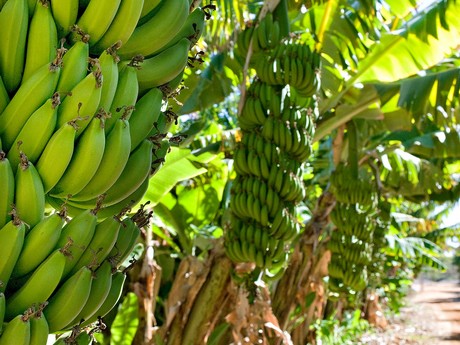Solution for: Growning banana
Answer Table
| 1. B | 7. uphill//on hillsides |
| 2. C | 8. lots of/plenty of water |
| 3. D | 9. plastic bags |
| 4. B | 10. bananas/ones (to) ripen |
| 5. one bunch | 11. C/D |
| 6. 15 months | 12. C/D |
Exam Review
Growning banana

F = Fiona M = Martin
F: Hi there, Martin. How are you going with your Australian studies tutorial paper?
M: Oh good. I’ve finished it actually.
F: Lucky you. What did you do it on? I’m still trying to find an interesting topic.
M: Well ... after some consideration I decided to look at the history of banana growing in Australia.
F: (surprised) Banana growing!
M: Yes, banana growing.
F: (sarcastically) Fascinating, I’m sure!
M: Well ... it’s not as boring as you’d think. And I wanted to tie it in to the work I’ve been doing on primary industries and the economy. Anyway I bet there are a few things you didn’t know about bananas!
F: Such as?
M: Such as the fact that bananas were among the first plants ever to be domesticated.
F: Oh, really?
M: Yes, they’re an extremely nourishing food.
F: I suppose you’re going to tell me the whole history of banana growing now aren’t you?
M: Well, it’d be a good practice run for my tutorial next week. I’ll do the same for you some time.
F: OK. Fire away. So where were these bananas first domesticated?
M: According to my research, the Cavendish banana, which is a type of banana and the first type to be cultivated here, actually originated in China but they had a fairly roundabout route before they got to Australia.
F: You mean they didn’t go straight from China to Australia?
M: No, they didn’t. It seems that in 1826, bananas were taken from South China to England.
F: I suppose they would have made a welcome addition to the English diet.
M: Yes, I’m sure. Well apparently there was an English Duke who was particularly fond of bananas and he used to cultivate them in his hothouse, which is where you have to grow them in England, of course, because of the cool climate and they became quite popular in the UK. So he was the one responsible for cultivating the Cavendish banana which was then introduced into Australia.
F: I see. And we’ve been growing them ever since?
M: Yes.
F: Are they hard to grow?
M: Well, yes and no. To grow them in your garden, no, not really. But to grow them commercially you need to know what you’re doing. You see you only get one bunch of bananas per tree and it can take up to three years for a tree to bear fruit if you don’t do anything special to it. But this period is greatly reduced with modern growing methods, particularly in plantations where you have perfect tropical conditions.
F: Right! So what are you looking at? One year? Two years?
M: No, no, around 15 months in good conditions for a tree to produce a bunch of bananas. And once you’ve got your bunch you cut the bunch and the plant down.
F: So how do the trees reproduce then?
M: Well, bananas are normally grown from suckers which spring up around the parent plant, usually just above the plant. They tend to like to grow uphill or at least that’s the common wisdom.
F: So that’s why banana plantations are usually on hillsides, is it?
M: Yes. They grow best like that.
F: That’s interesting!
M: If you plant them in rich soil and give them plenty of water at the beginning of summer, then they should be well advanced by the beginning of winter when growth virtually stops. But in a country like England, they’re hard to grow, although you can grow them in a hothouse.
F: But in Australia, it’s not difficult?
M: No, though even here, the growers put plastic bags around the bunches to protect them and keep them warm. If you go up to the banana growing districts, you’ll see all these banana trees with plastic bags on them.
F: But how do they stop the bananas going bad before they reach the shops?
M: Well, the banana bunches are picked well before the fruit is ripe. Once you cut the bunch, the bananas stop growing but they do continue to ripen. The interesting thing is that once one banana ripens, it gives off a gas which then helps all the others to ripen so they pretty much all ripen within a few hours of each other.
F: Amazing! So do we export lots of bananas overseas, to Europe and Asia for instance?
M: Well, oddly enough, no. I believe New Zealand takes a small proportion of the crop but otherwise they’re mostly grown for the domestic market, which is surprising when you think about it because we grow an enormous number of bananas each year.
F: Yes, well thank you for all that information. I’m sure the tutorial paper will go really well you certainly seem to have done your research on the subject.
M: Let’s hope so.
Questions 1-4
Circle the correct answer.
1 At first Fiona thinks that Martin’s tutorial topic is
A inappropriate.
B dull.
C interesting.
D fascinating.
1. Answer: B Locate Listen from here
2 According to Martin, the banana
A has only recently been cultivated.
B is economical to grow.
C is good for your health.
D is favourite food.
2. Answer: C Locate Listen from here
3 Fiona listens to Martin because she
A wants to know more about bananas.
B has nothing else to do today.
C is interested in the economy of Australia.
D wants to help Martin.
3. Answer: D Locate Listen from here
4 According to Martin, bananas were introduced into Australia from
A India.
B England.
C China.
D Africa.
4. Answer: B Locate Listen from here
Questions 5-10
Complete Martin’s notes.
Use NO MORE THAN THREE WORDS for each answer.

Commercially grown banana plant
Each banana tree produces 5 of bananas.
Answer: one bunch Locate Listen from here
On modern plantations in tropical conditions a tree can bear fruit after 6
Answer: 15 months Locate Listen from here.
Banana trees prefer to grow 7
Answer: uphill//on hillsides Locate Listen from here and they require rich soil and 8
Answer: lots of/plenty of water Locate Listen from here.
The fruit is often protected by 9
Answer: plastic bags Locate Listen from here.
Ripe bananas emit a gas which helps other 10
Answer: bananas/ones (to) ripen Locate Listen from here.
Questions 11-12
Circle the TWO correct boxes.
Consumption of Australian bananas |
||||||||||||
|
11. Answer: C/D Locate Listen from here
12. Answer: C/D Locate Listen from here
Other Tests
-
-
Total questions: 0
- 10- Summary, form completion
-
Total questions: 6
- 6- Sentence Completion
-
-
Total questions: 0
- 10- Summary, form completion
-
Total questions: 10
- 10- Sentence Completion












